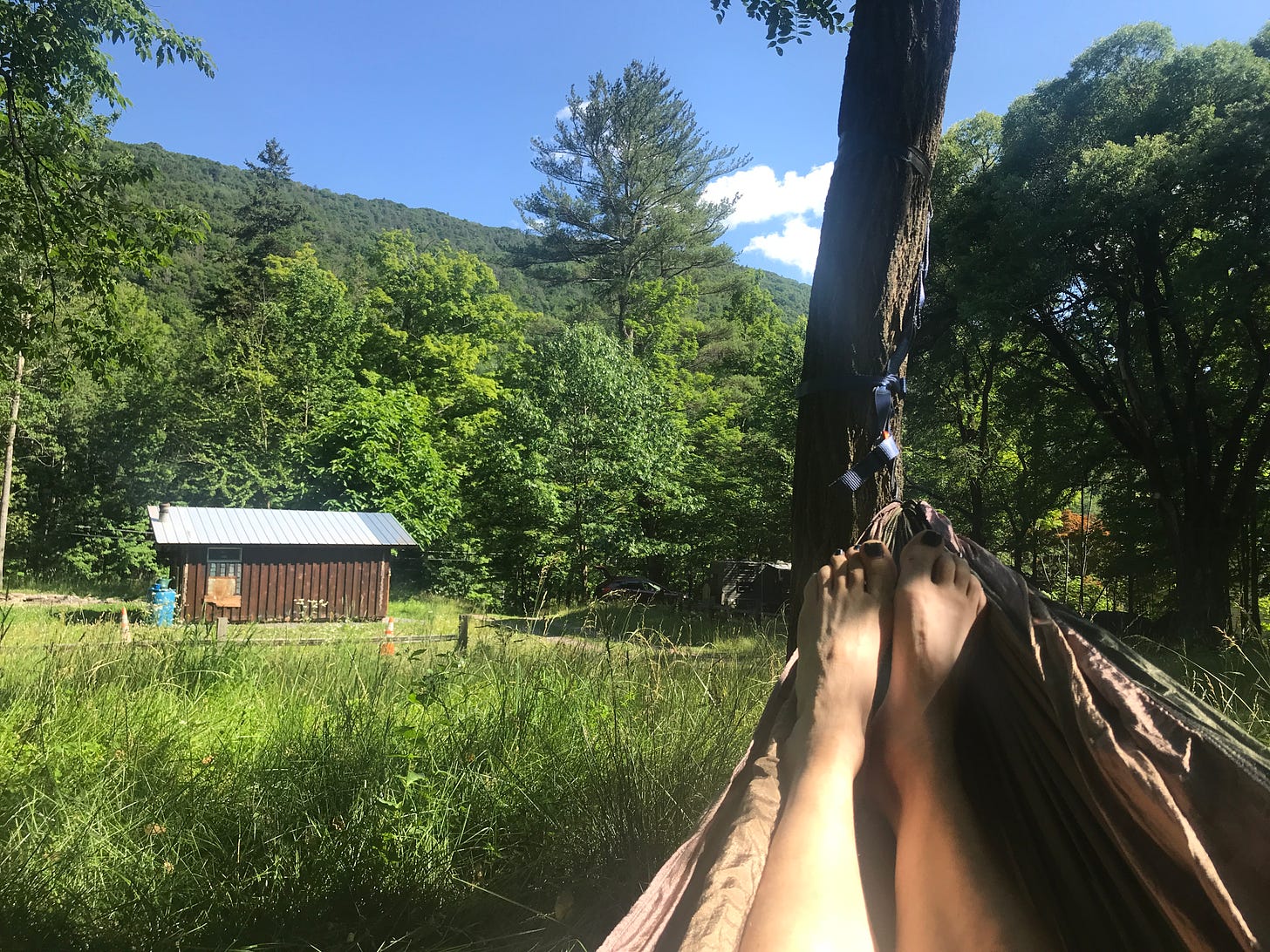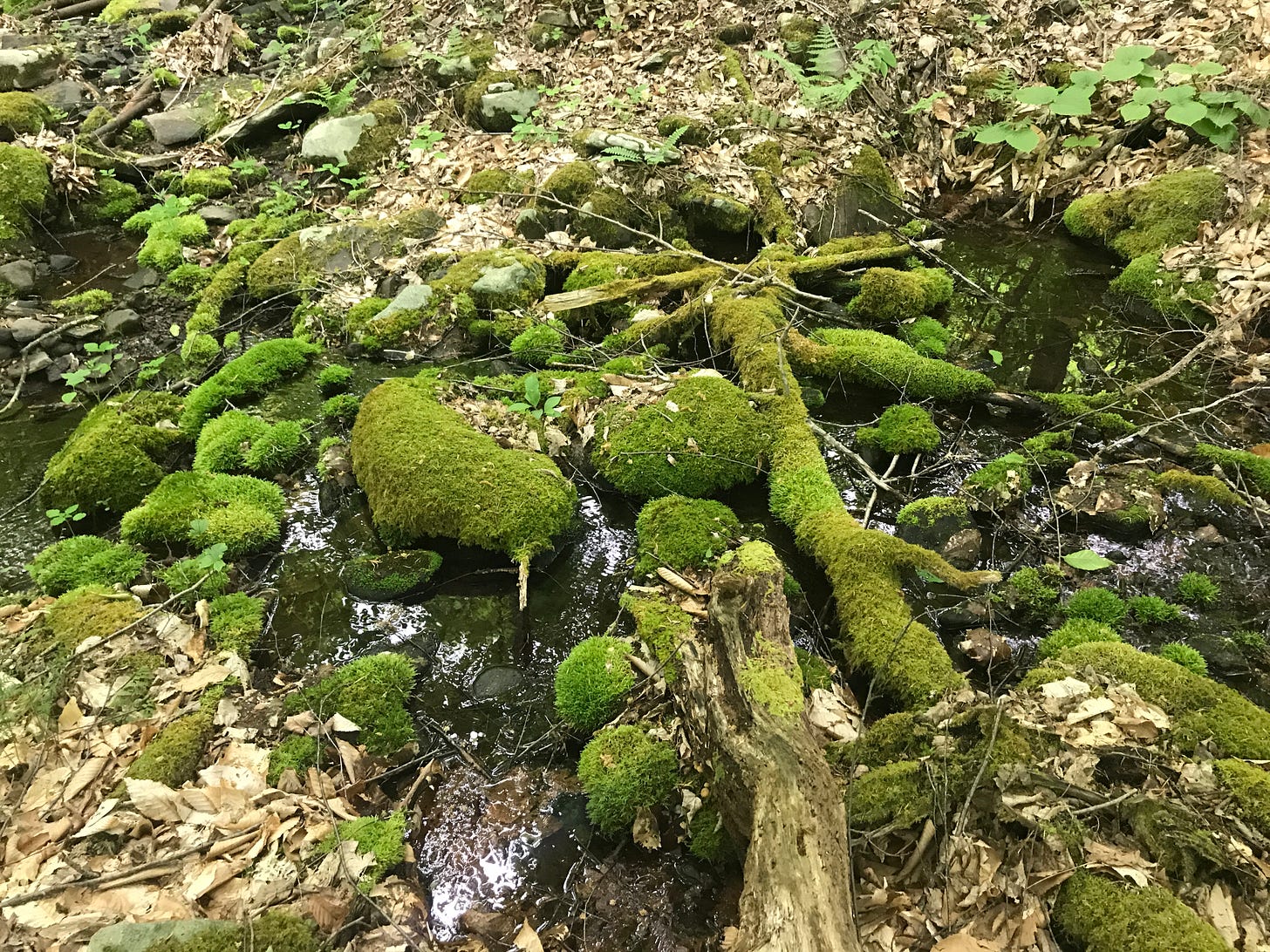I played with shades of blue in my water trilogy, now I’d like to launch a trilogy about color itself. Part 2: Green.
Sponsor

For the most part, my little sliver in upstate New York is green. Then, it turns into a spectrum of colors during the fall, then goes brown and finally blinding white. I much prefer green. It’s green and not blue—I only Hear Watch the water dripping from the barrels or the stream. The result of the blue I can’t see is all this green I can. With the rainy season this year reaching tropical levels, it is more important than ever. Green that breathes, and burps, and fuels my nightmares as I can’t keep up, can’t control the rude disregard of any imposed border, any attempt at discipline, choking every approved seedling with wild grasses, mugwort and thorns. Clogging up my mower, until it stops. I’ve scythed, chainsawed, clipped and clawed. I weeded the skin from the undersides of my index finger. This brambled battle is a lost cause.
I love it. Nature’s not trying to kill me, but keep me alive.
In a “Nurtured by Nature” article from the American Psychological Association, studies show that the color green saves lives, or close to it:
It is beneficial to spend time in the natural world. Both correlational and experimental research have shown that interacting with nature has cognitive benefits—a topic University of Chicago psychologist Marc Berman, PhD, and his student Kathryn Schertz explored in a 2019 review. They reported, for instance, that green spaces near schools promote cognitive development in children and green views near children’s homes promote self-control behaviors. Adults living in public housing units located in areas with greater green space performed better on attentional tests than adults who lived in units that had less natural environment access. In experiments, it was found that natural environments improved working memory, flexibility of the brain and attentional controls, while urban environments tended to cause attention deficits.
Why does green space have this benefit? Scientists propose three theories. Biophilia Our ancestors were able to survive in the wild, so our instinct to be outside is not new. Second, the Stress Reduction hypothesis posits that “spending time in nature triggers a physiological response that lowers stress levels.” And the third, Attention restoration theory, says that “nature replenishes one’s cognitive resources, restoring the ability to concentrate and pay attention.”

But, if I may, I would like to hear more hypotheses from the scientists about their hypotheses. We know intuitively—because we clearly experience it—that access to nature reduces stress and cleans our cognition, but more interestingly for science is, What is the best way to get in touch with you??
Another study suggests that children’s experiences outside have a lasting impact. In a study of residents of Denmark, researchers used satellite data to assess people’s exposure to green space from birth to age 10, which they compared with longitudinal data on individual mental health outcomes. Researchers analyzed data on more than 900,000.000 Danish residents born between 1985-2003. Researchers found that those children who grew up in neighborhoods with a greater amount of green space were at a lower chance of experiencing a variety psychiatric disorders in later life. This included schizophrenia, depression, mood disorders and eating disorders. The risk of mental illness is 55% higher for children who have had the least exposure to green space during childhood.
Simple solutions can sometimes be found for complicated problems. I think there’s simplicity and slowness calling to us in the green space. It’s time to pay attention. Our attention is typically—at work, school, home—scattered by competing demands, messaging blipping at us from every screen. Here’s room to notice, contemplate. You can breathe in the air deeply here because it is cleaner. In such an environment, you might feel more inclined to move. Push through brambles to discover a world covered in moss fit for fairies. Get on hands and knees to find a four-leaf clover that leads to a weird pocket of hundreds (I’m not kidding). Or a coyote will howl here, a snake startle you—all the better to get your numb heart racing.


Green isn’t risk-free. It’s mold. Slime. Glow-in-the-dark alien skin. Tiny worms hanging from invisible threads in the sky. The metaphysical film’s beating heart The FountainWhere the green crazy life may just save or end your life. (Time stamp of the verdant tree with oozy leaves, 7 minutes).
Then there’s the historic toxicity of green and this paint everyone loved so much they’d die for it. Ironically green, the color chosen by the recycling movement, contaminates recycling:
Historically, green has been a difficult color to create—it often faded, degraded, and even burned holes through canvas. In the 18th and 19th century, green wallpapers and paints contained arsenic, which off-gassed toxic fumes and led to many deaths—possibly including Napoleon Bonaparte’s in 1821. Emerald green (also known as Paris Green) was extremely toxic. It was used at one time to kill rats from Parisian sewers.
Even though the use of many super toxic greens has been banned, the pigments that are currently used to make them are still hazardous. As Alex Rawsthorn of the NYTimes reports, Pigment 7, one of the most common shades of green used in plastic and paper, contains chlorine, which can cause cancer and birth defects. Pigment 36 contains potentially hazardous bromide atoms as well as chlorine, and Pigment Green 50, which is inorganic, contains a “noxious cocktail of cobalt, titanium, nickel and zinc oxide.” So having direct contact with the pigments is unsafe, and on top of that, the pigments make green plastics and paper difficult to recycle or compost, because they contaminate everything else. If what Braungart says is true, then perhaps it’s time to choose new team colors.
I have a book in my brain that I’ve been working on (mentally) since I owned a bar in Brooklyn in an old tenement that I exposed for the original tin-ceilinged space it was once—perhaps a bar!—from 1890. In my novel about this space there will be a literal “pick your poison” drink menu, bowls of lead paint chips to nibble on, and seething walls of Paris Green. My grandfather used to tell me how he used to eat the paint chips he flaked off his house growing up—how sweet they tasted.
It occurs to me as I write this that the beautiful riffs on One Word that Taegan MacLean produces might have a green episode in his archive, and sure enough, he captures exactly this paradox between fresh and rotten, healthy and toxic that this color encapsulates—from teeming clover fields to a father on his deathbed. From his post on Green:
The slimy excretions and gentle chlorophyll of toads. Close my eyes, and I can see fields of bright clover that are as bright as the sun. Live and prospering. I also see my dad on his deathbed. The sting of alcohol wipes. And the pungent, nasally-green that hung over the bedroom during those last months.
The root of green, in over a dozen languages, means to grow. How do I grow? How about a fresh, spring-like ascent into the skies? Or do you want to go down to the damp, dark earth?
Green’s unique attribute is its spectrum. Up and down. Sickness versus health. Death and Life. It touches an inexplicable aspect of earthly life. As summer approaches and the sun’s warm breath spreads across the land before the blue jays and daffodils, we see bursts green. In the shadows of the forest, where the sunlight cannot reach, the mold that grows on the fallen trees and the verdant decay is spread like cancer.
Green is also associated with attention. Like the sun, I will grow what I am focused on. What I ignore will rot. Green is paradoxical.
Green is not my favorite color—I won’t even wear it, let alone paint my real room with it, but it is what I gravitate to most in nature. What do you prefer? A typical dating app prompt. For me it’s definitely mountains. I want access to some body of blue to float in as nearby as possible, but it’s the green that chloroPhylls me. The wild and the work, both bittersweet.
In the contest between what’s better for you, green (land) or blue (water), one study demonstrates that blue might edge out on measured benefits, or it’s a pretty close tie.
Anyway, this isn’t a contest.
It’s a fight for your life.
[Next stop: red.]